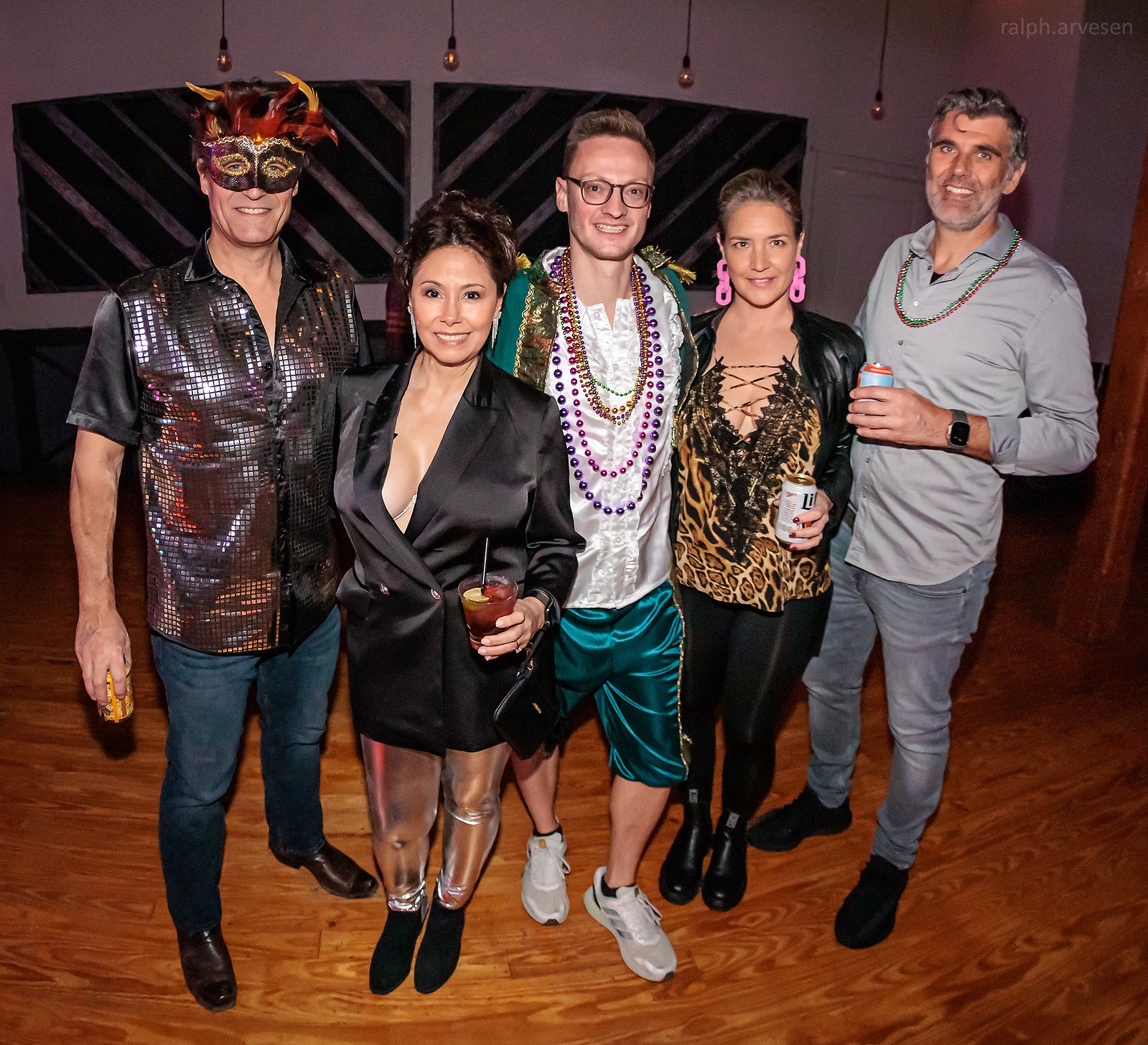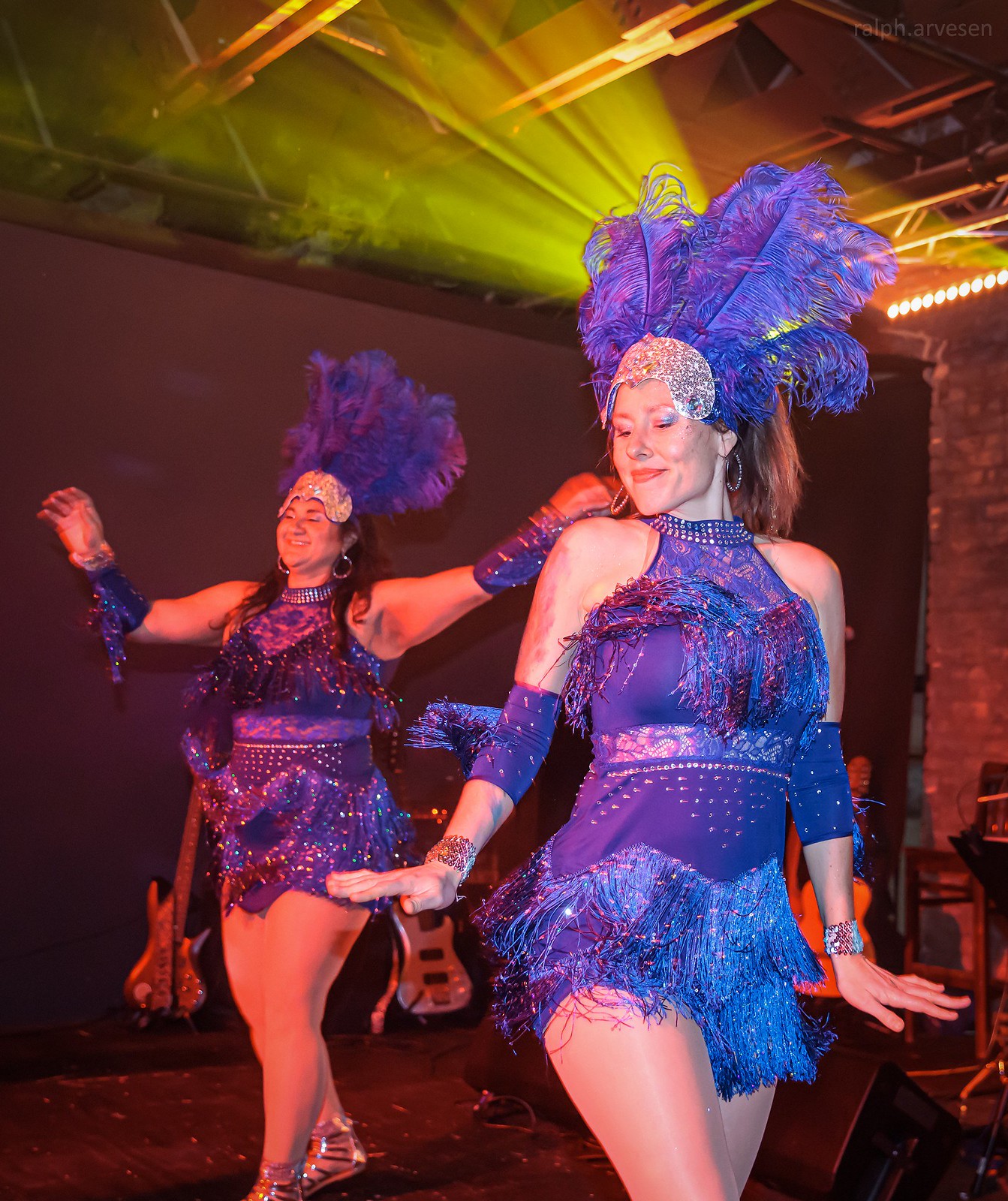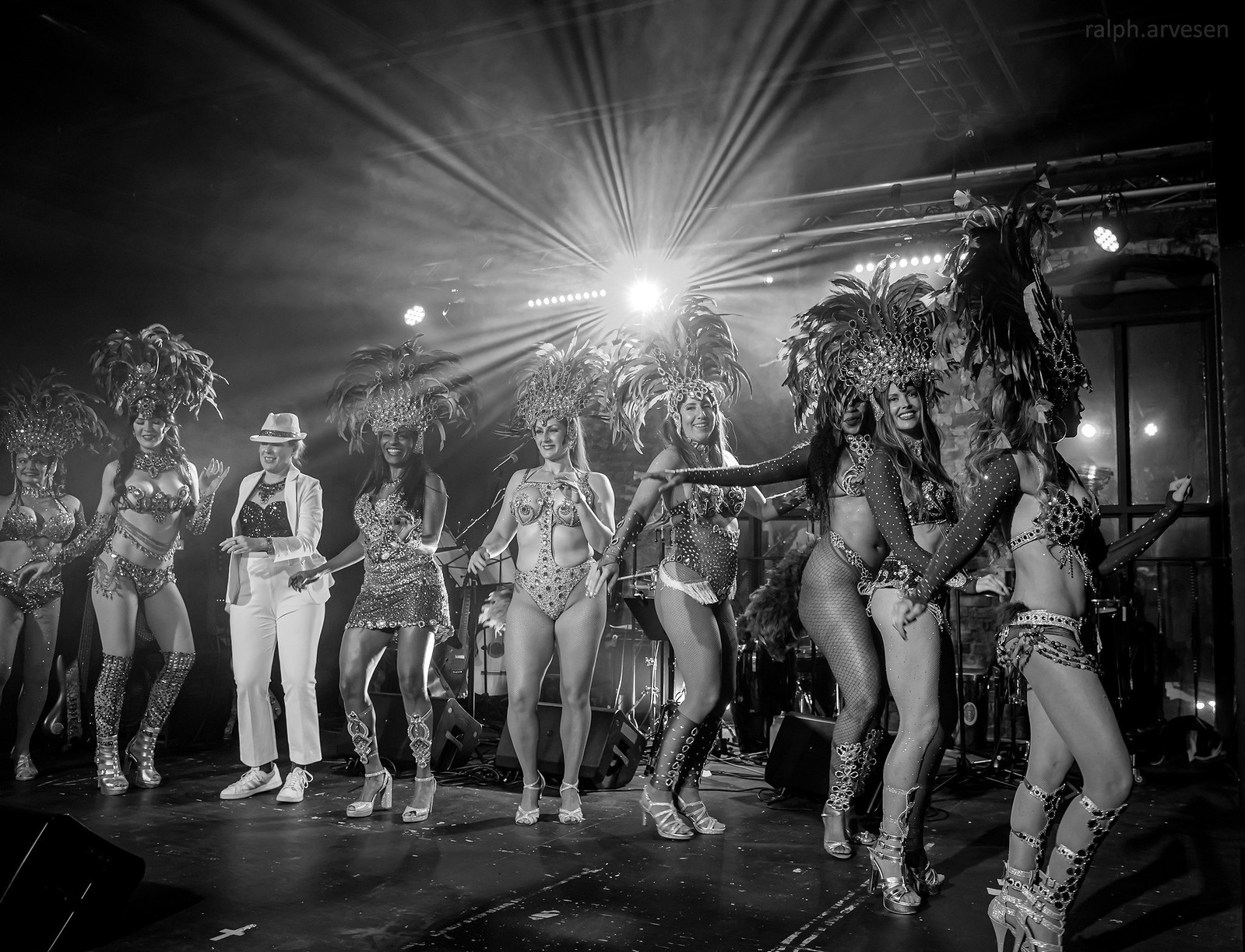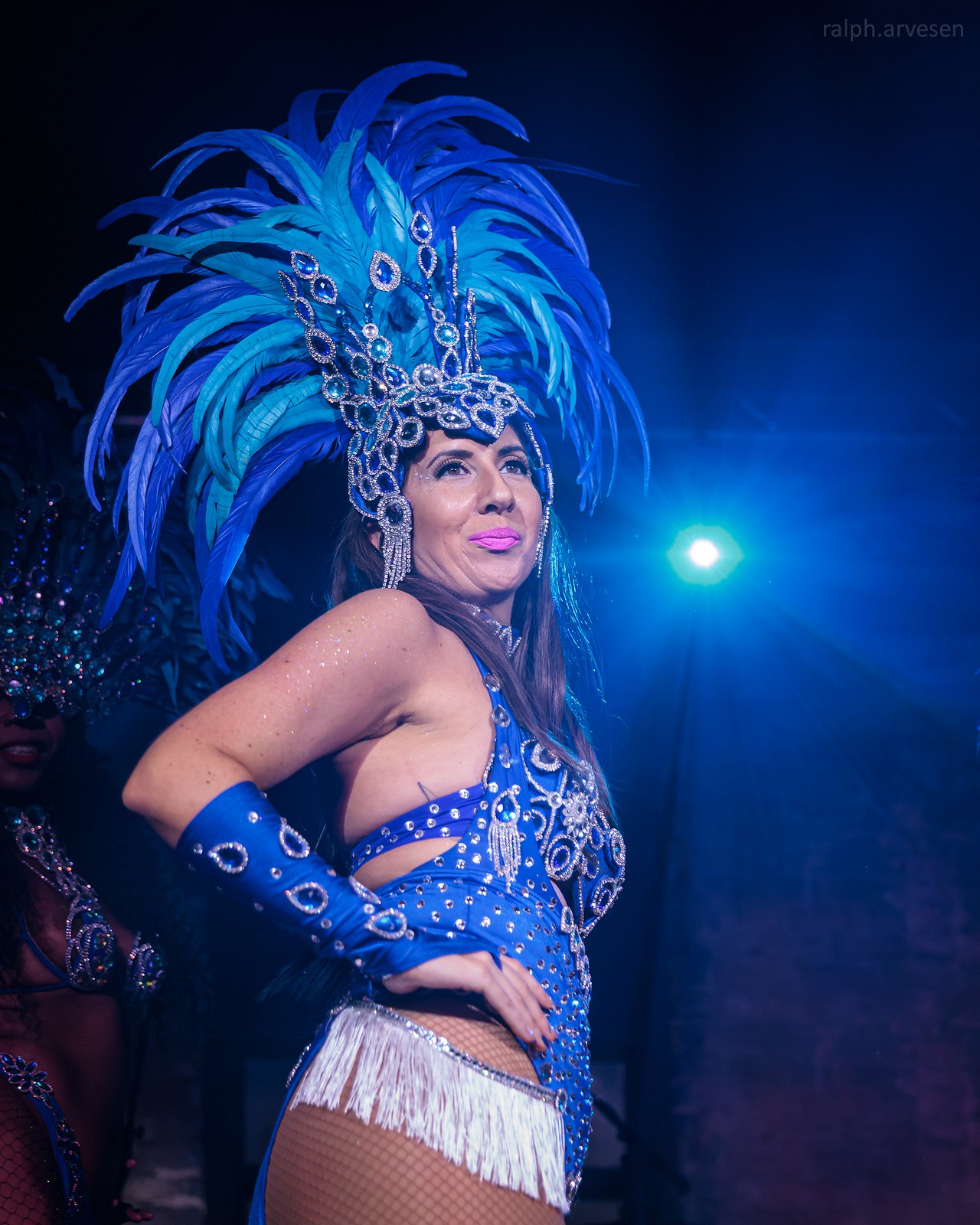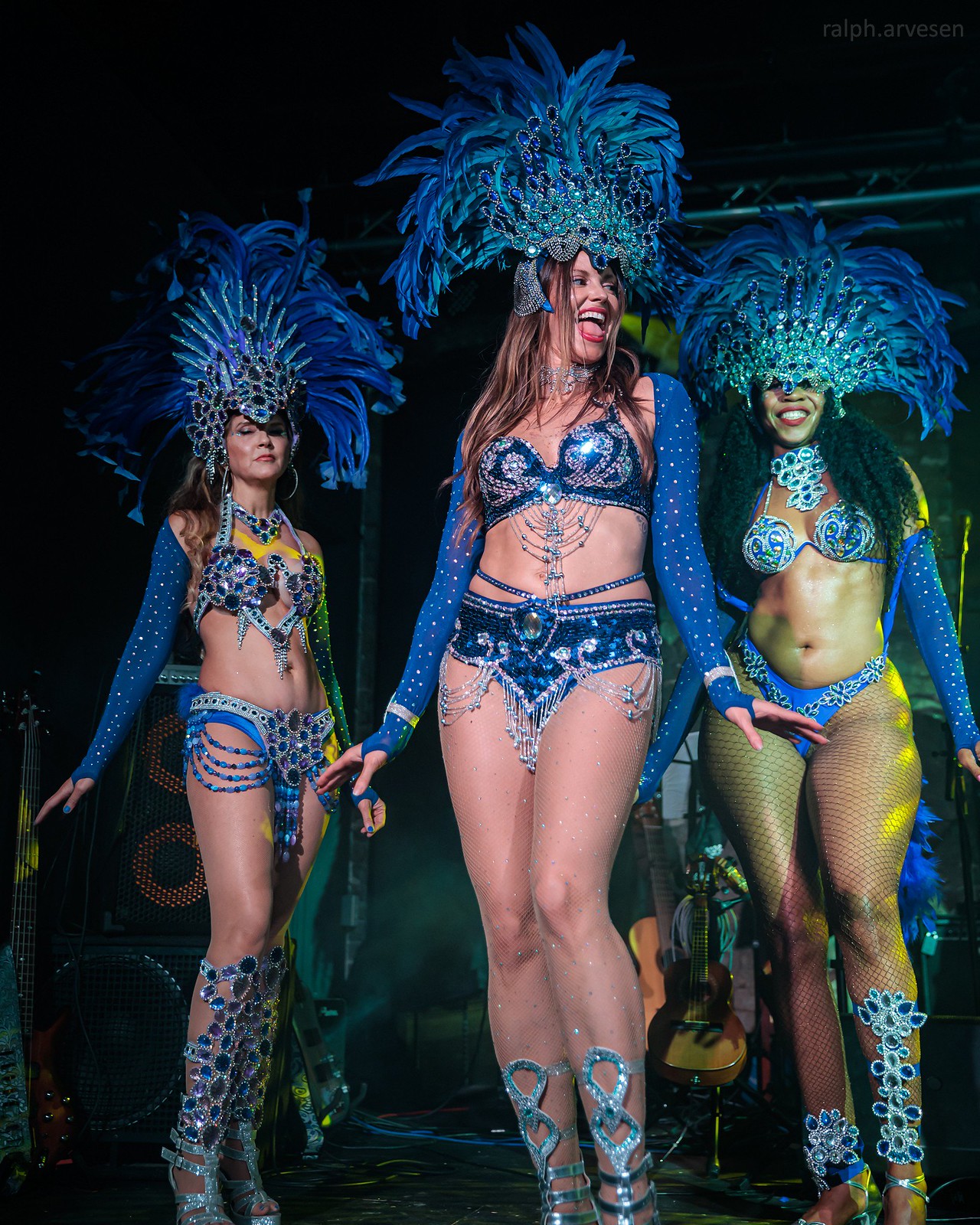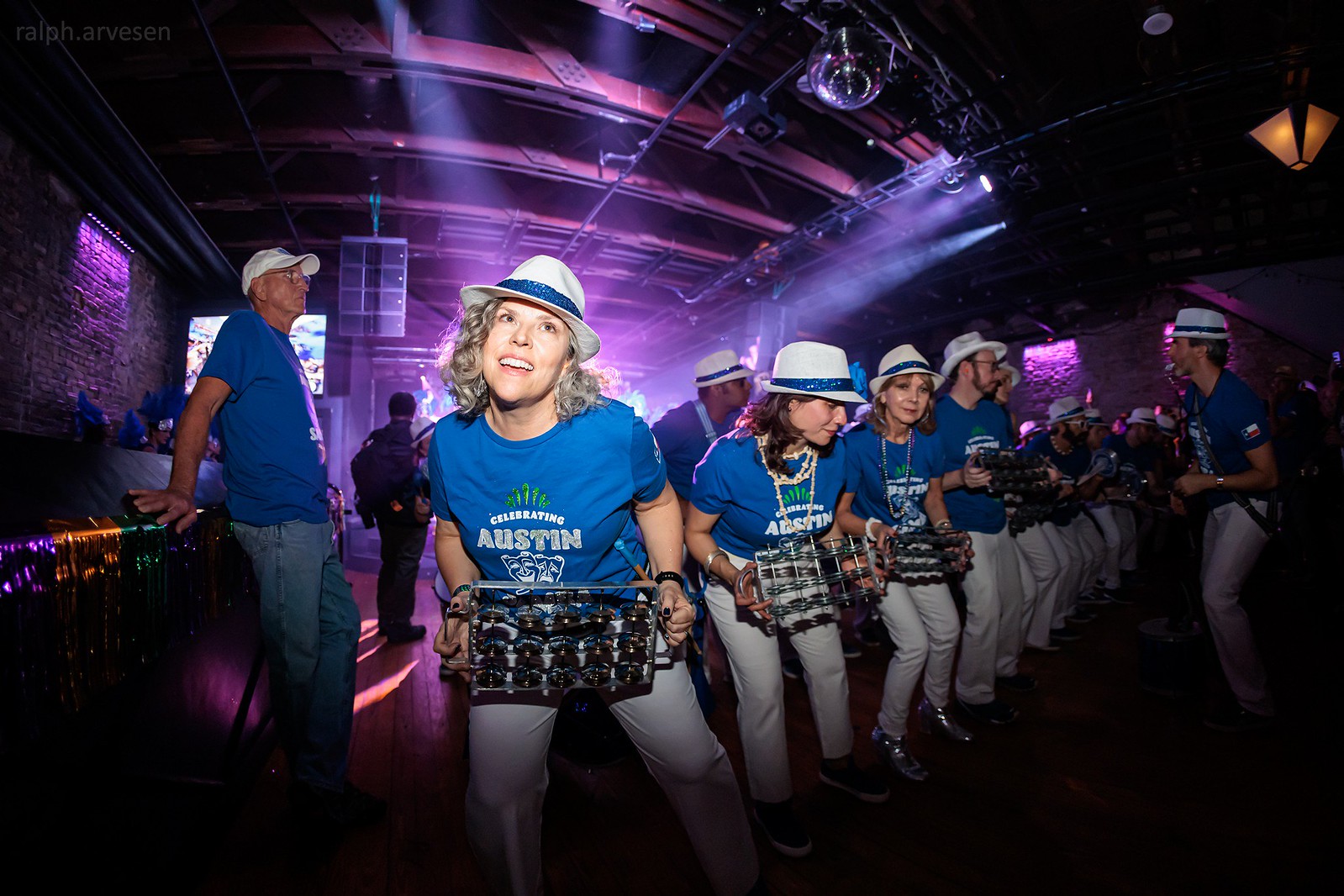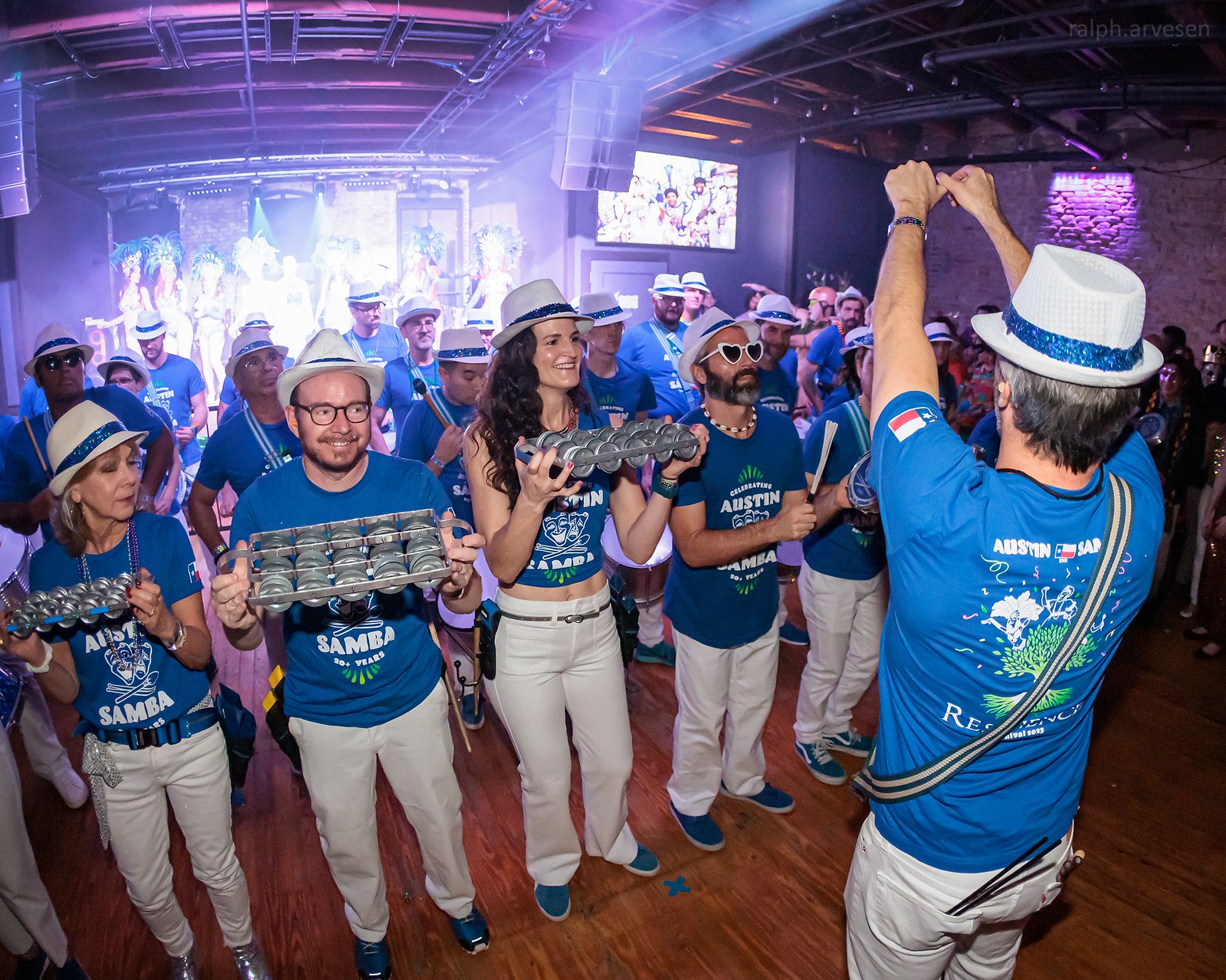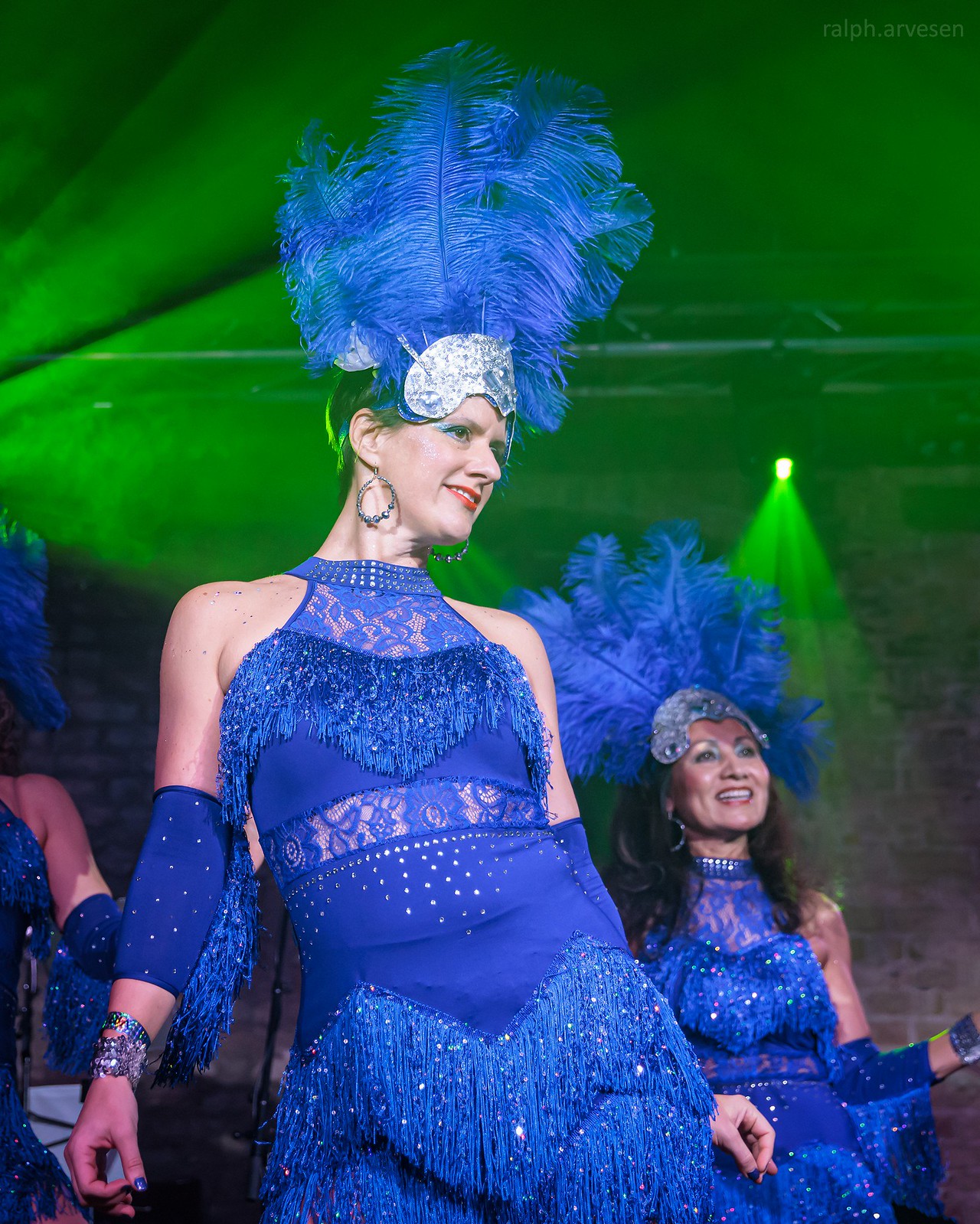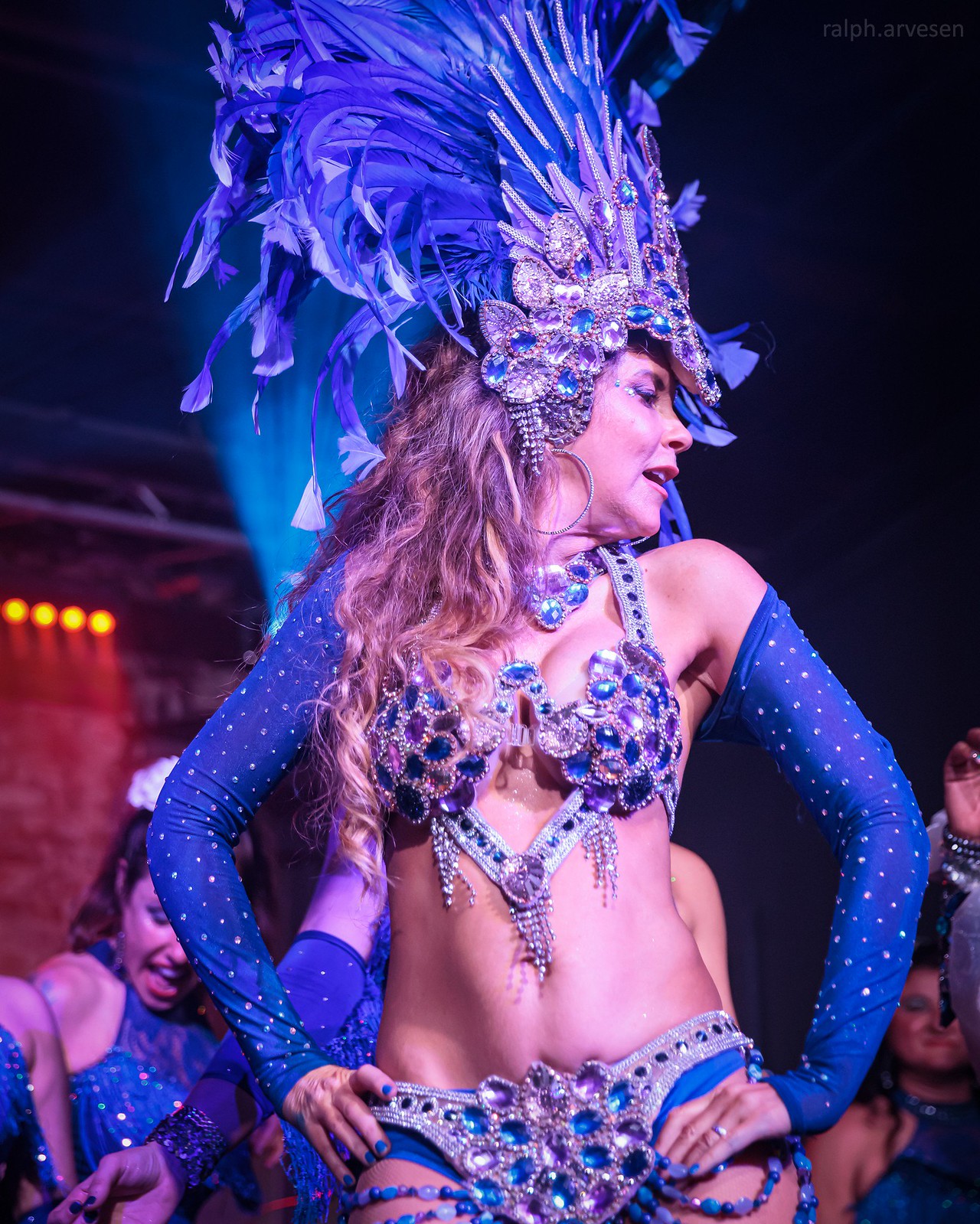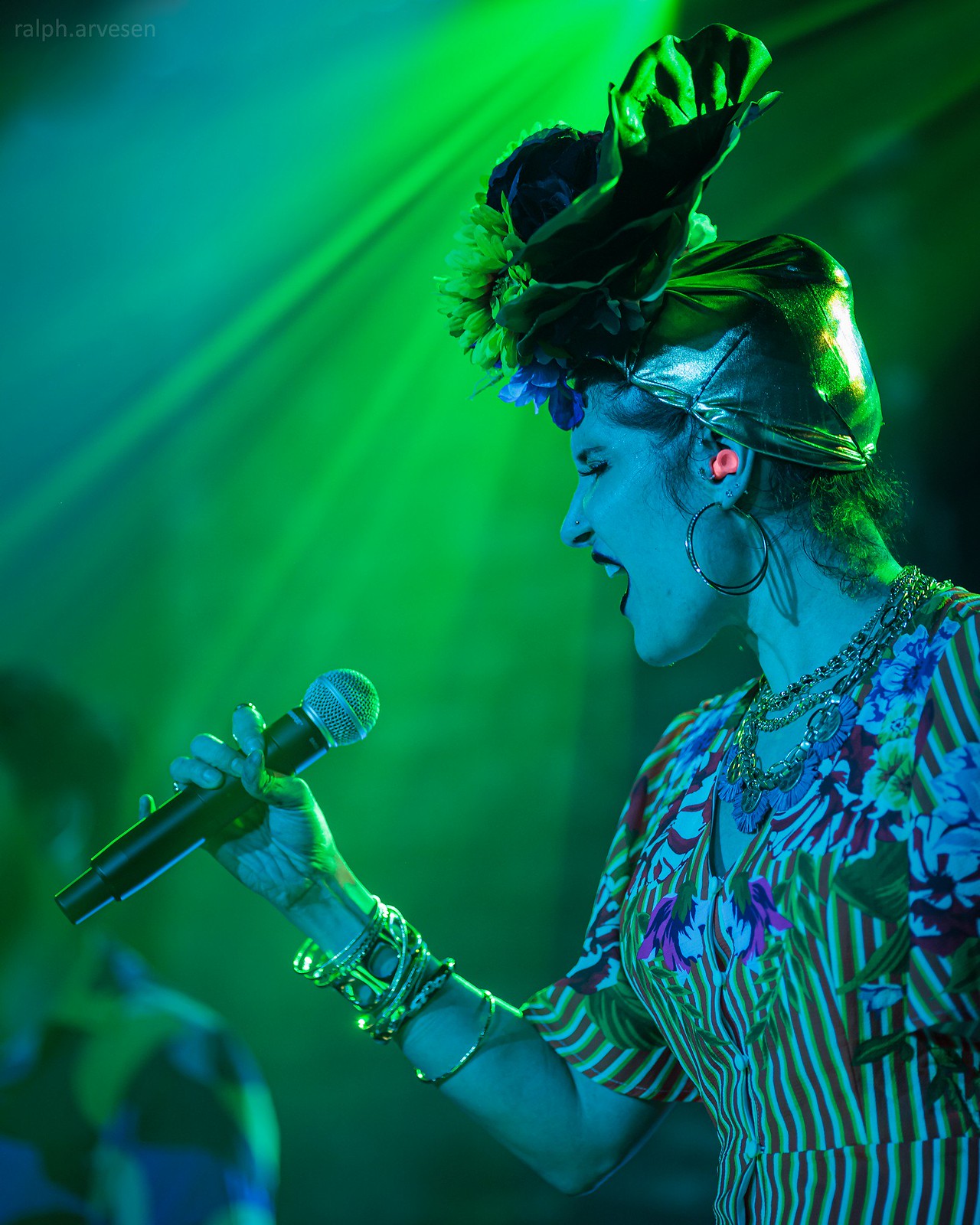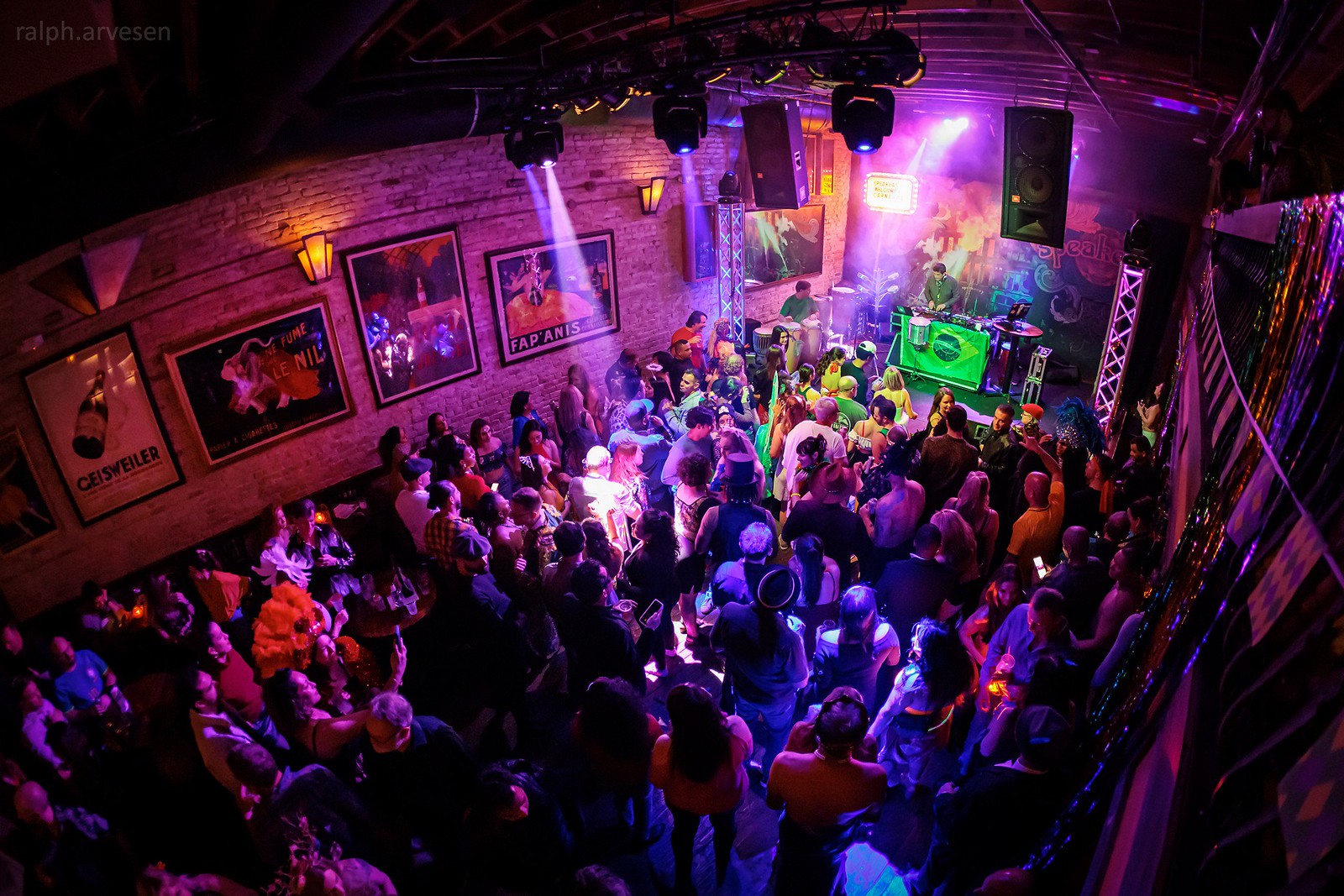
Carnaval Brasileiro at the Speakeasy in Austin, Texas on February 4, 2023. (Photo: Ralph Arvesen)
Austin is still a young city, in search of its own traditions. Though we have come up with a few native creations, Austinites still borrow and adapt traditions established elsewhere. Our public festivals, for example, tend to mirror those civic events promoted by local governments and chambers of commerce from coast to coast.
So why would a mid-sized Central Texas city boast a Brazilian carnival, lifted straight out of Rio, with purely Brazilian music played on Brazilian instruments, and sung entirely in Portuguese? The story of CARNAVAL BRASILEIRO in Austin is a curious one, yet it typifies the way things often happen in this community.
First, some basic facts. Carnaval in Brazil derives from the medieval Christian revels in Europe held just prior to the forty days of Lent. This annual festival of flesh was further enriched in Brazil by African rhythms, especially the samba. Carnaval is an all-consuming nationwide festival in Brazil, celebrated by all social classes over a period of several days, or, in reality, many weeks. It is a social cathartic for Brazilian society, particularly for the sweating masses of urban poor dancing in the summer streets who, at least for a few precious days, can masquerade as the wealthy upper class.
These few facts already suggest that what we celebrate in Austin is only a sample—although a totally authentic one—extracted from its social context in Brazil. We have the equivalent of a middle-class, indoor CARNAVAL DE SALÃO, or CARNAVAL DE PULÃO (Ballroom Carnaval or Big Jump Carnaval), but held for one night only, in the middle of winter. And, of course, the crowd consists mainly of gringos who have no idea how to dance samba and cannot understand a single word of the music. Very curious. But they do have a good time, and a truly magical ambience is created, despite the crowded dance floor that, by 10:30pm, resembles something like a tremendous example of human bumper cars. One eight-year old in attendance once described the scene was like “being stuck inside a giant washing machine.” Totally apropos!
With this in mind, let us see how that exotic import called Carnaval Brasileiro came to be what Texas Monthly has touted as the state’s “best public bash.”
It all began around 1975. At that time there were many Brazilian scholarship students at UT taking a six-week long intensive English course. Faced with the prospect of a February without CARNAVAL, they decided with their local friends to hold their own celebration: Carnaval ’75 took place in a small room at Austin’s Unitarian Church (which is into almost anything). The two hundred or so revelers had planted a seed.
For the next several years the party moved further downtown, drawing ever larger crowds. Carnaval ’76, held at The Bucket, a bar then located on West 23rd Street, drew over three hundred folks who struggled to keep their footing covered with an inch or two of spilled beer. A highlight of that evening was the thunderous collapse of a low stage under the weight of fifty wildly drumming Brazilians. They just looked at one another for a second, saw no one was hurt, and partied on! A group of devoted “Brasilianistas” continued to organize a Carnaval that began growing rapidly beyond their control.
The last party to retain the original University focus was held at the Dobie Center in 1977, with over five hundred participants. The size of the crowd and problems with the homestyle sound system pointed up the need for a large hall with professional sound equipment. And as the number of scholarships dwindled, the Brazilian students were gradually submerged into a Carnaval that Austinites were already making their own.
At this point Mike Quinn entered the picture. Quinn, (for ten years the producer of Horizontes, a daily radio program dedicated to the music of Latin America on KUT-FM, Austin’s NPR affiliate), was in 1978 a lowly, but ambitious retail clerk at Discount Records across from the University of Texas campus. Mike undertook the organization of Carnaval ’78 as an outlet for his own creative interests in Brazilian music.
The celebration, held at the double-tiered Boondocks Club (later infamous as Club Foot) on East Fourth Street in downtown Austin, was the take-off for Carnaval Brasileiro as we know it today. Carnaval 1978 packed in over a thousand bodies, sweating and gyrating to the drumming of Austin’s first Carnaval group: an ad hoc assembly of local musicians including ethnomusicologists from UT and members of Beto y Los Fairlanes, all under the direction of Dr. Gerard Behague of the UT Department of Music. Though the drumming was improvised, the atmosphere was magical, and it set the stage for the live music featured at every Carnaval since. Because, by 2:00am every drop of alcohol in the place had been sold, the party was able to continue on until 4:00am. Because of so many enthusiastic, serious dancers, the club had to repaint the dance floor the following week!
Accordingly, in 1979 Carnaval moved into the legendary Armadillo World Headquarters (sadly, now defunct), where Austin’s first Brazilian band, Os Imperialistas do Samba (later Unidos de Austin), played to a capacity house of 1800. The night’s three dollar tickets were scalped outside for as much as twenty-five bucks.
In 1980 Carnaval Brasileiro finally moved to the warehouse-like Coliseum, which, despite two sojourns at Austin’s 7,000 capacity Palmer Auditorium (1981 and 1984), became its home until 2003 when the party moved into its current home, the Palmer Events Center on the shores of Austin’s Town Lake.
The 1980 Carnaval also inaugurated the classic series of Austin artist Guy Juke’s poster and T-shirt designs. In 1993, Colombian-born artist A. J. Garces created the majority of Carnaval posters, most in a style reminiscent of 1940s pinup art. Other artists have included Jota Borges, one of Brazil’s most renowned folk artists, Austin-based Susannah Blanton, Brazilian cartoonist Redí, and a few others.
The event continued to grow in size and sophistication throughout the ’80s as organizers searched for the right formula to make the party sizzle. The earlier costume contests have been dropped because they interrupt the flow of the music and dancing, being replaced with large video screens flanking the stage which help highlight some of the more spectacular costumes and the performers on stage.
The music of Carnaval — SAMBA, MARCH, FREVO, TRIO ELÉTRICO, and lots of BATUCADA, or drumming — now pours out in seamless, driving, ninety-minute sets. This is the euphoria of a real Carnaval, magnified by an arena-style sound system that makes three or four drums sound like a hundred. The key to the samba sound is the heavy boom of the surdo bass drums set against the counter-rhythms and back beats for the smaller percussion. When all of this is on the mark, samba kicks ass! You can see it on the faces of the crowd as people begin to lose control and abandon themselves to the charged atmosphere.
From about 1988 through 2000, music was provided by Susanna Sharpe and the Samba Police, a local Austin group dedicated to performing accurate renditions of Brazilian music. In 2000, a group of 13 percussionists from Rio’s oldest samba school (escola de samba), Portela, performed along with Susanna and her group. For 12 years, beginning in 2003, the featured band was Beleza Brasil, a group of ten or more Brazilians carnaval veterans, based in New York, but who have more than two centuries of combined experience performing carnaval music in Rio and the United States.
Carnaval Brasileiro has been attempted in Houston on three occasions, from 1980 to 1982, and in 1987. The gig at the Washington Square Emporium in 1980 featured Unidos de Austin in a poorly heated converted warehouse on a bitterly cold evening. It was so cold that everyone wore their coats over their costumes. Things warned up later when a big, brawny, bald, Brazilian worked up a sweat doing the limbo on the floor. With the steam rising off his scalp, he looked as if he had been electrocuted!
Carnaval Brasileiro has now become an Austin institution, one that nobody really planned as such. A small party grew into a giant public bash because there were Brazilians who needed a celebration, local individuals to nurture it along the way, a radio program (Horizontes) to promote its music, a series of bands to play the music, and, above all, enough Austinites who felt the magic and kept coming back for more.
This is an Austin story, one that has yet to really take off in Houston, Dallas or San Antonio, despite larger Brazilian (and other Latin) populations, consular officers, and potential public interest.
Carnaval has emerged and thrived in Austin, because long ago it became a city of open attitudes and spontaneity, due in large part to the university influence. Now that bohemian attitude has mixed with just enough business sense and hard work to make music happen in a way that is attracting attention from around the world. Perhaps the greatest monument to that spirit-the defunct Armadillo World Headquarters-is now just a memory. But Austin’s Carnaval Brasileiro, our peculiar winterfest of flesh and fantasy, was nurtured in that unique semi-cohesive, culture-conscious environment, and still flowers every February.
Carnaval Brasileiro
web | facebook | twitter | instagram
Photos by Ralph Arvesen
web | facebook | twitter | instagram




